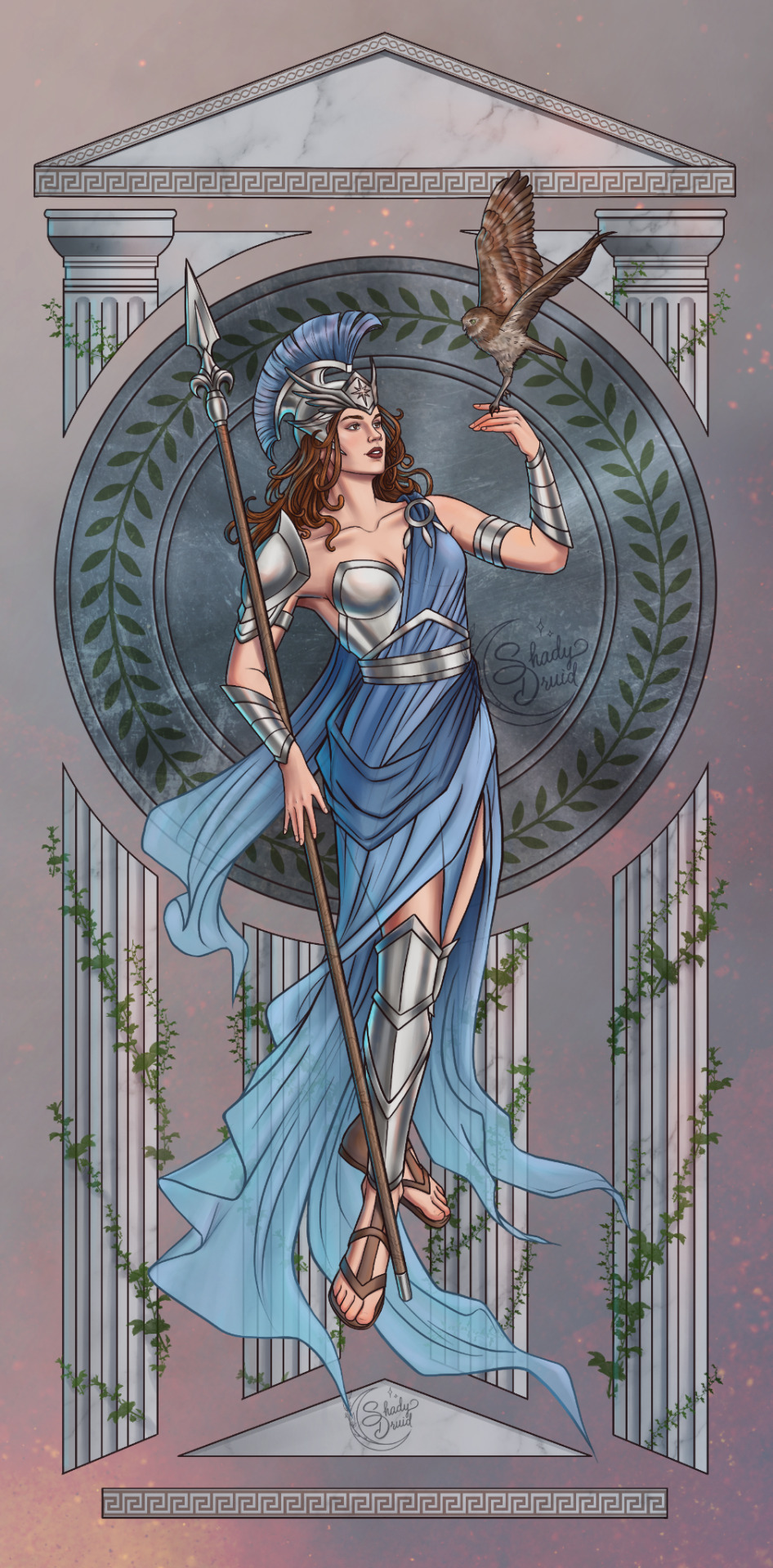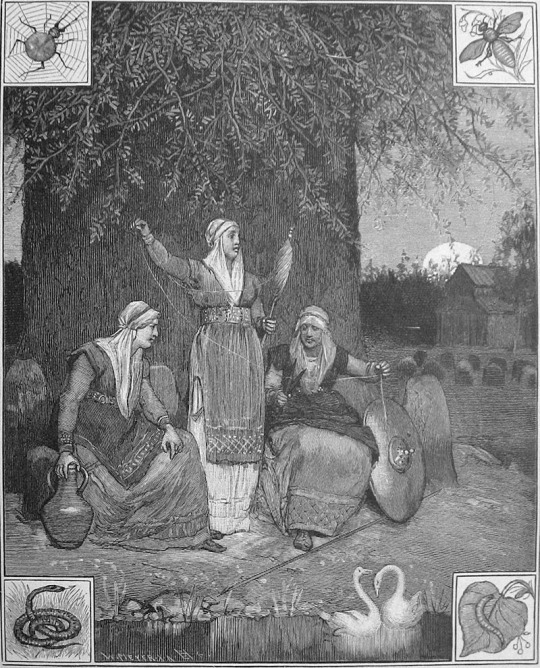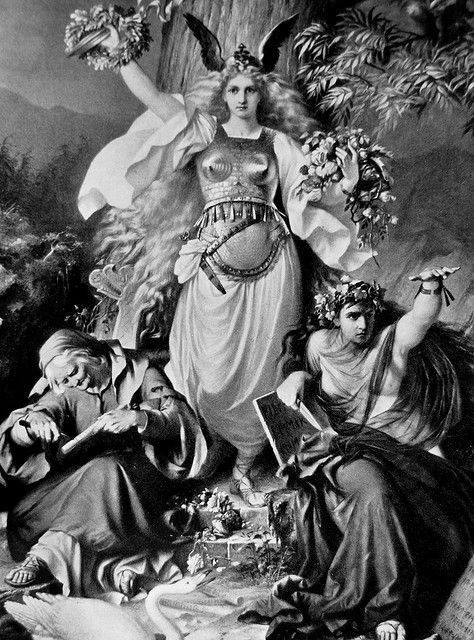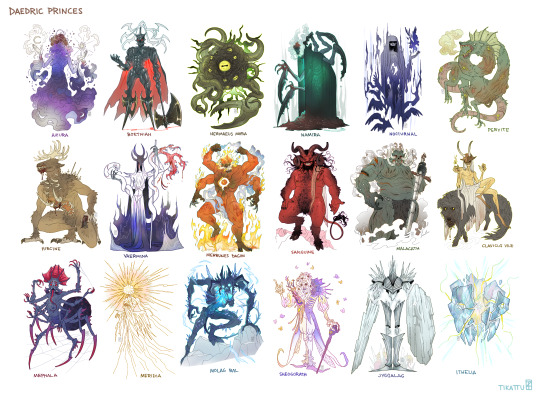main: @samwis. Side blog for my spiritual path. You can call me Solar or Jamie, I'm 26, use any pronouns. I worship norse, hellenic and pop culture deities. I practice divination, spirit work and some magic.
Don't wanna be here? Send us removal request.
Text
Annual Witchblr reminder that Hecate's origin is ancient Greece, not Wicca.
Hecate being three formed (Trimorphis) represents her domain of the crossroads, not the maiden/mother/crone triple moon goddess. Hecate predates Wicca and its triple goddess by at least couple thousand years.
451 notes
·
View notes
Text
Generative AI is NOT Worship
I saw a post about this but it was written by a fucking "radfem" FART, and I don't want to give that POS the time of day. So I'm going to make my own.
Generative AI does NOT please the gods. If you make one of those devotional digital offerings and you use AI to do it, you're spitting in the face of the gods. They do not accept it.
Generative AI steals from actual artists (and I'm saying this as a devotee to a god of thieves), it scrapes protected data from all corners of the web. It permanently damages the connections in the brain for recall, creativity, and cognitive processing. And it poisons and harms the very earth we are supposed to honour.
It doesn't matter if the art you create yourself is "good" by some sort of scholarly pseudo-objective standard or not. It is good simply for the fact that you made it yourself out of the love and honour of the gods. It could be a stick figure with stickers all around it, but the fact that YOU made it - not prompted some AI slop - means that it is worthy in the eyes of the gods as a good offering.
You should put your energy, your feelings, your mind into your offerings. Something Generative AI can NEVER do.
395 notes
·
View notes
Text
Lately, I've been seeing a few videos that I disagree with, so I'll sum up my thoughts here.
You do not need to be white to be a Norse pagan.
You do not need to have Nordic or Norse ancestry to be a Norse pagan.
You can be a Norse pagan regardless of race, skin color, or ethnicity.
471 notes
·
View notes
Text




🌿 Who are the Landvættir?
In norse mythology, the Landvættir are spirits that inhabit nature. They protect it and will drive away or harm those who do not respect it.
Some say that they are tied to a particularly beautiful thing in an area, like a waterfall, a big rock or a tree. Others say that, while they don't leave the part of the land they protect, they aren't bound to a specific place.
The Landvættir are said to be responsible for how healthy and fertile the plants and animals are, that inhabit the space. If the Landvættir are weak, so is the nature around them.

🌿 How can I build a good relationship with them?
Regular Blóts (sacrifices) in the form of food have been a common practice throughout history.
Leave some fruits or vegetables that are safe for the local wildlife outside for the spirits. Handmade offerings from natural materials (carved wood, flower crowns, a song sung by yourself or played on an instrument, or other similar things) are usually welcome too.
Be careful about not using anything that could harm the environment like glue or wood stain.
If you have a garden, be sure about taking care of it well. Plant native plants for pollinators and water them regularly.
If you've done your part for a while, you can ask the Landvættir for help with specific things, like increasing your harvest. Once they help you, don't stop doing all the things you've done before. This is a long term symbiotic relationship.
If you make a mistake and accidentally spill something that's toxic to the environment, forget to take care of your plants or forget to leave out food for the spirits regularly, apologize sincerely and try your best to fix the mistake.
Landvættir are known to be easy to anger if you sabotage their well-being, may that be on purpose or accidental. It is likely that they will retaliate, but don't let that stop you from trying to make it right. Once they realize you're doing more good than you are doing harm, they will calm down again.


click here → My Etsy Shop


pngs used in the header image are by @whizpurr and @pngblog
114 notes
·
View notes
Text
Hellenic polytheism isn’t just about revering the gods. It’s about loving them so deeply you could cry just from thinking about it, sob from the loving ache that a single prayer unleashes. It’s about love, unconditional and complete love, for both the gods and yourself. It’s about hearing their whispers in the wind, and their embrace from behind when you’re sad and sorrowful.
146 notes
·
View notes
Text


Athena, Goddess of Wisdom, inspired by Epic:the Musical and Teagan Earley ❤️🔥
2K notes
·
View notes
Text
Greek mythology books (nonfiction)
I was asked about this, so here are some books I like, in no specific order:
Early Greek Myth: A Guide to Literary and Artistic Sources by Timothy Gantz.
The Routledge Handbook of Greek Mythology by Robin Hard.
A Companion to Greek Mythology edited by Ken Dowden and Nial Livingstone.
The Cambridge Companion to Greek Mythology edited by Roger D. Woodard.
The Gods in Epic: Poets and Critics of the Classical Tradition by D. C. Feeney.
The Daily Life of the Greek Gods by Giulia Sissa and Marcel Detienne.
Greek Nymphs: Myth, Cult, Lore. by Jennifer Larson.
A new Companion to Homer edited by Ian Morris and Barry Powell.
The Cambridge Guide to Homer edited by Corinne Ondine Pache.
Homer's Divine Audience: The Iliad's Reception on Mount Olympus by Tobias Myers.
The Iliad – the Poem of Zeus by Pietro Pucci.
Zeus in the Odyssey by J. Marks.
Brill's Companion to Hesiod edited by Franco Montanari, Chr. Tsagalis and Antonios Rengakos.
•The Oxford Handbook of Hesiod edited by Alexander C. Loney and Stephen Scully.
Hesiod's Theogony: from Near Eastern Creation Myths to Paradise Lost by Stephen Scully.
The Hesiodic Catalogue of Women and Archaic Greece by Kirk Ormand.
The Hesiodic Catalogue of Women: Constructions and Reconstructions by Richard Hunter.
Hesiod and Classical Greek Poetry: Reception and Transformation in the Fifth Century BCE by Zoe Stamatopoulou.
The Greek Epic Cycle and its Ancient Reception: A Companion edited by Marco Fantuzzi and Christos Tsagalis.
The Tradition of the Trojan War in Homer and the Epic Cycle by Jonathan S. Burgess.
The Epic Cycle: A Commentary on the Lost Troy Epics by M. L. West.
The politics of Olympus : form and meaning in the major Homeric hymns by Jenny Strauss Clay.
Traditional Themes and the Homeric Hymns by Cora Angier Sowa.
The Homeric Hymn to Demeter: Translation, Commentary and Interpretive Essays edited by Helene P. Foley.
The Homeric Hymn to Aphrodite: Introduction, Text, and Commentary by Andrew Faulkner.
Orphic Traditions and the Birth of the Gods by Dwayne A. Meisner.
The Derveni Papyrus: Cosmology, Theology and Interpretation by Gábor Betegh.
The Derveni Papyrus: Unearthing Ancient Mysteries edited by Marco Antonio Santamaría Álvarez.
Chaos, Cosmos and Creation in Early Greek Theogonies: An Ontological Exploration by Olaf Almqvist.
When the Gods Were Born: Greek Cosmogonies and the Near East by Carolina López-Ruiz.
Mythica by Emily Hauser.
Women and Weasels: Mythologies of Birth in Ancient Greece and Rome by Maurizio Bettini.
Ancient Stepmothers: Myth, Misogyny, and Reality by Patricia A. Watson.
Gender and the Interpretation of Classical Myth by Lillian E. Doherty.
The Story of Myth by Sarah Iles Johnston.
Drakon: Dragon Myth and Serpent Cult in the Greek and Roman Worlds by Daniel Ogden.
Zeus by Ken Dowden.
Classical Zeus: A Study in Art and Literature by Karim Arafat.
Aphrodite by Monica S. Cyrino.
The Origin of Aphrodite by Stephanie Lynn Budin.
Entre ciel et guerre. Figures d’Aphrodite en Grèce ancienne by Gabriella Pironti.
The Hera of Zeus: Intimate Enemy, Ultimate Spouse by Vinciane Pirenne-Delforge and Gabriella Pironti.
Hermes by Arlene Allan.
Artemis by Stephanie Budin.
Apollo by Fritz Graf.
The Power of Thetis: Allusion and Interpretation in the Iliad by Laura M. Slatkin.
The Staying Power of Thetis: Allusion, Interaction, and Reception from Homer to the 21st Century edited by Maciej Paprocki, Gary Patrick Vos, David John Wright.
Athena by Susan Deacy.
Dionysos by Richard Seaford.
Perseus by Daniel Ogden.
Herakles by Emma Stafford.
The Oxford Handbook of Heracles edited by Daniel Ogden.
Heracles in Early Greek Epic edited by Christos C. Tsagalis.
Helen of Troy: Beauty, Myth, Devastation by Ruby Blondell.
Achilles in Love: Intertextual Studies by Marco Fantuzzi.
Medea by Emma Griffiths.
Looking at Medea: Essays and a Translation of Euripides’ Tragedy edited by David Stuttard.
Medea: Essays on Medea in Myth, Literature, Philosophy, and Art edited by James J. Clauss and Sarah Iles Johnston.
87 notes
·
View notes
Text


Working on some Norse God Inspired altar pieces for my upcoming fairs. This one is for my personal altar but soon I’ll be making more with different bones and different gods as well.
Every new project brings me such happiness and fulfillment
71 notes
·
View notes
Text
Short guide to varðlokkr
Briefly exploring ritual singing and spirit work in the nordic tradition, and their possible uses in neo-pagan practice.


Before performing divination, it's said that völur would sing, or more often than not, have someone sing a ritual song in order to "rouse the spirits". This ritual was a way to call upon nearby spirits—generally guardian spirits, to come and answer their questions. The practice of varðlokkur, or "ward songs/protection songs", is tightly interwoven with the art of seiðr. According to the few sources that mention the topic, it was performed by seeresses seeking to prophecize, or by women willing to sing it in their stead.
Before diving deeper into this topic however, it's important to note that the interpretation of the term varðlokkr, and in a sense, the very basis of its current scholarly understanding, depends on its possible etymology. Two hypotheses stand out in this regard: varðlokkr is either spelled with one or two k's, either varðlok or varðlokk. The former would refer to "locking", or "fastening", and is often associated with a passage in the Grógaldr (The Spell of Gróa) where the shamaness refers to Urðar lokur, or Urð's locks/bolts. In this case, the song is a matter of "locking" the spirits in. Whereas varðlokkr would stem from the same root (vǫrðr, meaning to guard or ward), but in this case, lokkr would come from lokka, meaning to lure, or entice. It's generally agreed upon that both these instances showcase how the idea of protection was a key element in the perception of this practice.
These so-called "Weird-songs" sometimes required the use of a rhythmical sound created using drum beating, rattles, or by hitting the ground with a staff. They served as an invocation to higher powers or local spirits, who would be keen to protect ("ward") the seeress as she glimpsed into the future. According to pre-Christian belief, the sound of these songs had the power to appease surrounding spirits, but also to entice and lock them into the space for the duration of the divination. Letting her spirit wander out of her body in order to scry, the völva/seiðrkona became vulnerable, hence the need for higher protection. Now "bound" to her until the completion of the ritual, the guardian spirits would be inclined to lend their help. Depending on the intepretations, this type of ritual singing could also have been a means to reach a trancelike state before fortune telling.
'Many spirits,' said she, 'have been present under its charm, and were pleased to listen to the song, who before would turn away from us, and grant us no such homage. And now are many things clear to me which before were hidden both from me and others.' Eiríks saga rauða, chapter 3
The trance aspect of this practice is often debated, however. Granted, it's possible to point out similarities between seiðr and the "out of body" travel of Sámi and Siberian shamans. After all, a few sources tell us that varðlokkr would also serve to bring the völva back into her own body once she'd prophecized. Still, scholars more often than not consider varðlokkr and other seiðr practices as putting oneself in a "receptive state" in order to comprehend messages sent from the spirit world.
At the beginning of the séance all those present seem to have taken part in the singing, but a special choir was appointed for continuing operations: this is in several accounts said to consist of women or one woman. Singing continues throughout the séance, the purpose being to remind the shaman of his mission. Some sources indicate that the singing was concentrated or confined to the final stages of the trance, and the aim here was to wake the shaman. Louise Bäckman & Åke Hultkrantz
Think of varðlokkr as a way to blend music, divination and spirit work. A modern practitioner who already works with Dísir, vættir, ancestors, and the like can involve these familiar spirits in the ritual, for example, by calling upon a passed loved one to protect them during divination, or even to aid in finding answers. It's generally agreed upon that during the Scandinavian pre-Christian times, the wisdom of the dead occupied a vital place in many such shamanic practices. One could seek advice from passed mentors or loved ones in this manner. Even disregarding the idea of "rousing" spirits and "locking" them, I believe that one could still use to music as ritualized invocation—especially when it comes to ancestor work, in order to ask for advice or insight.
Next to nothing is known about what varðlokkr actually sounded like. However, I think it's still interesting to explore the idea of ritual singing as a shamanic practice. For someone interested in experimenting with galdr, seiðr, or any such shamanic practices in the Nordic tradition, varðlokkr seems like a great place to start.
So how does one incorporate ritual singing into neo-pagan practice? I'm sorry to say that it's exceedingly difficult to somehow reconstruct varðlokkr, as history has left us with nothing but bits and pieces to work with. However, three main particularities stand out and aid us in tracing a general outline: 1. the Weird-song is sung before divination as an opening practice; 2. its purpose is to call upon spirits; and 3. it most likely served as a sort of short-term ward for the person performing the ritual. These three concepts may be preserved, and the freedom to build around them is yours.
For this reason, we even have the option to simply pick a song which feels sacred and play it before rune casting, or tarot reading for example (needless to say such a practice also applies to any and all methods of divination, including scrying). After all, there's really no indication that the practitionner must sing the song themselves. Even in the few accounts mentioning varðlokkr, the seeress isn't always the one singing.
But if you decide to sing the varðlokkr yourself, it's also possible to learn the lyrics to a song that's already part of your practice. If working with the spirits of the dead, and especially with passed loved ones, why not play a song that a given ancestor loved in life? Artist Einar Selvik has composed a short skaldic-type song called Vardlokk, which has understandably become my own ritual song. I play it to get into a spiritual state of mind, helping me tremendously before spirit work—which coincides in many ways with the original purpose of varðlokkr. But it's safe to say any type of music may be used. And if you're interested in trance or trance adjacent practices, chanting may be used in such a manner as well.
There are many ways for us neo-pagans to adopt the practice of varðlokkr, since in one way or another, music is always tightly intertwined with religious practice. One can choose to wholly disregard the spirit work aspect and simply explore the idea of ritual song and its ties to divination. No matter the case, shamanic practices were an inherent part of Nordic religious tradition, and I think it can be useful for modern practitioners to learn about them and explore the possibilities that they offer.
If you're interested in further reading, I've linked at the beginning of this post an ask I answered a while back pertaining to seiðr, galdr, and other shamanic practices of the Norse. Within the post are also a few suggested pieces of reading that have helped my personal understanding and research.
212 notes
·
View notes
Text
Deities For Beginners
─── ⋆⋅☆⋅⋆ ──
Okay... I've been seeing a lot of misinformation and misconceptions regarding deities, so I'd like to contribute a little bit to the conversation. Fyi, this is from the perspective of a polytheist, not a witch!
─── ⋆⋅☆⋅⋆ ──
"How do I talk to the Gods/how do I start working with them/how do I ask to work with them?"
Honestly, you don't know, and you don't need to. A lot of people start out obsessed with direct communication and instant gratification. All you need is intention: start praying. Paganism is about building connections and relationships. Those take time. You will learn your Gods. You don't need them to magically manifest in front of you, and I honestly don't recommend divination to "talk" to them, at least until you have enough experience to discern actual interactions from nothing at all.
"Is [insert God] mad at me?"
Have you caused terrible harm to someone intentionally? Have you shown unprecedented levels of hubris? No? Then they aren't. This question is usually a result of the questions from earlier. Just because you don't feel them during your first ritual, or life throws something at you, does not mean the ancient forces of the universe have it out for you. Take your time, recenter yourself, and remember that the Gods hear you and they are there.
"Oh you worship [insert God]? Aren't they...evil?"
No! Hope that helps! Jk jk. The myths are stories that allow us some degree of historical context for how the original practitioners viewed the Gods and what their practice was like. Through their cultural lens, we get a decent picture of what the Gods are like. However, that does not make the myths literal depictions of the Gods, and it's actually a major red flag to treat them as such.
"Are all the Gods just the same few Gods viewed differently by different people?"
So, this is the soft vs. hard polytheism question, and honestly, I personally find soft polytheism (all pantheons are the same God/few Gods in different forms) to be problematic. Are Wodin and Odin the same? Yeah, you could argue that they share a common origin. Are Zeus and Odin the same? No, and you really can't argue that.
─── ⋆⋅☆⋅⋆ ──
Anyways. These are some of the more common questions I'd like to answer. I would love to elaborate if needed! Also, if anyone has other questions, I'll answer to the best of my ability.
188 notes
·
View notes
Text
It’s so weird to me when I bring up I’m Hellenic and ppl treat it like a joke or like a fandom thing???
Like chat no this is literally my religion. I believe in the Hellenic pantheon. I pray to all of them. I give Gods offerings. I started using the pen name of Eros because the idea of him was what pulled me out of years of dissociation and trauma. Yes I worship Eros.
I seriously don’t mind ppl asking questions but there’s a way to phrase things, especially when talking about religion :/
740 notes
·
View notes
Text

Sheogorath. Might come back to this later.
2K notes
·
View notes
Text



Apollo, the ancient Greek and Roman god of the sun and light, patron of the arts, leader and patron of the muses, predictor of the future, god of healing, patron of immigrants, personification of male beauty. One of the most revered ancient gods. I tried to saturate the composition as much as possible with attributes and characters that describe Apollo. For example, a muse with a scroll is present here to emphasize his connection with art, poetry and even science. In the background is Daphne, a beautiful nymph transformed by the gods into the first laurel tree, which would later become the sacred tree of Apollo
In contrast to Dionysus, who is the moon god and personifies the element of chaos, Apollo is a solar deity who brings the light of order and harmony. this and other figurines in my Etsy store
29 notes
·
View notes
Text
I don't know who needs to hear this but it's ok if you can't hear your deities talking, whether physically or mentally
It's ok if you don't dream with them
It's ok if you can't feel their presence
It's ok, darling!
They still love you. They love you very dearly, just as much as you love them!
738 notes
·
View notes
Text

after a whole year of avoiding this task, i have finally drawn jyggalag, the only daedric prince my redesign project was missing! the gang's all here!! i also updated vaermina's and sheogorath's colors a little.
5K notes
·
View notes

